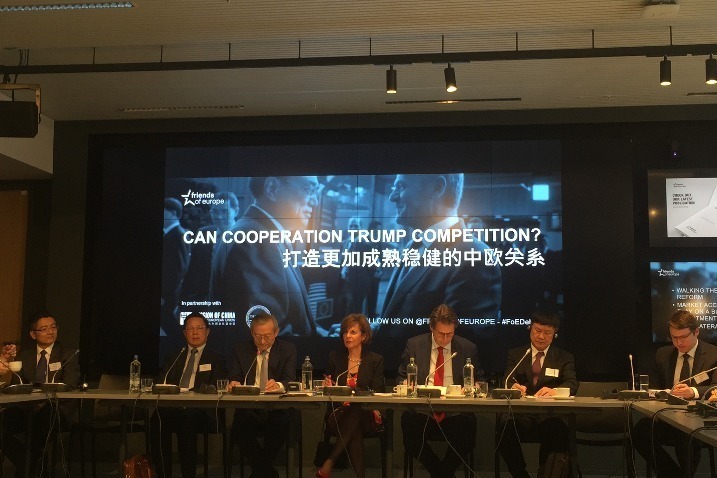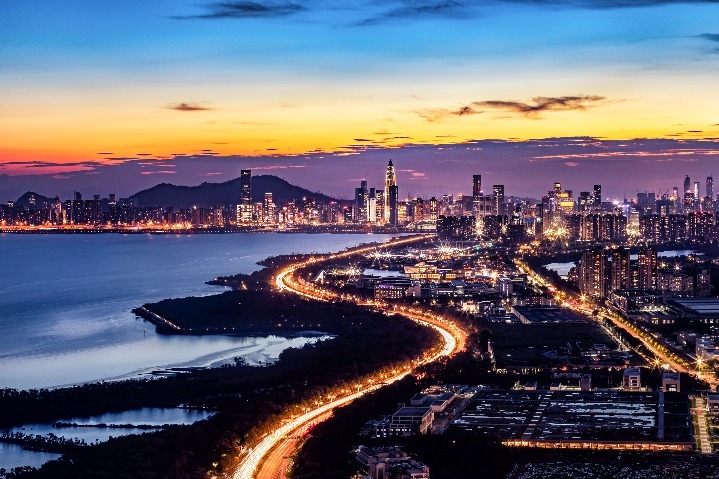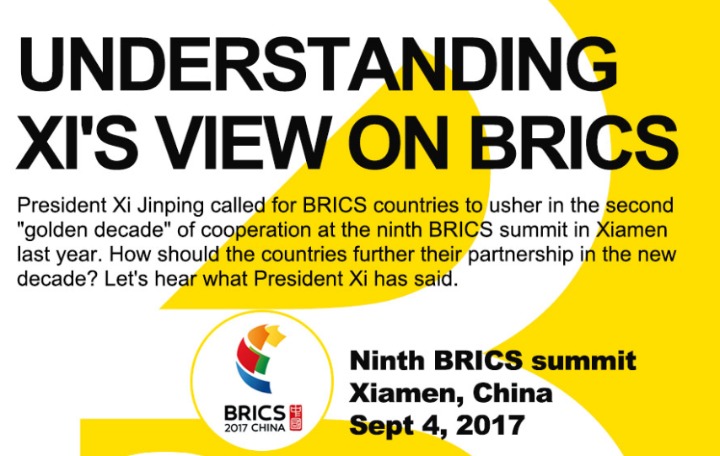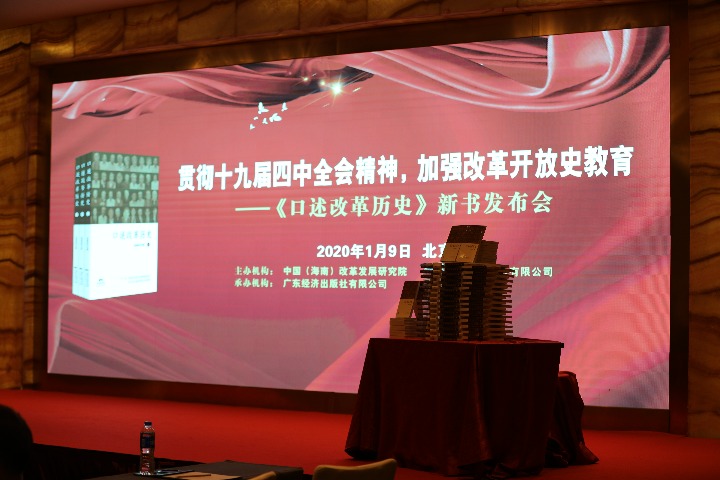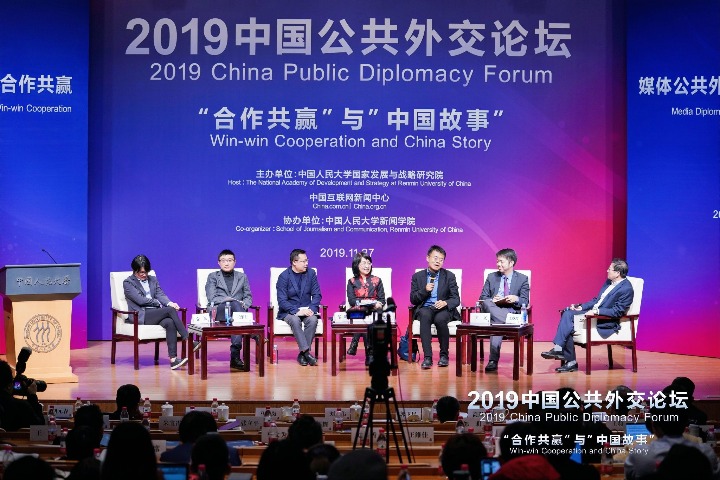Think tanks focus on 'trade war' solutions
By Zhang Zhao |
China Watch |
Updated: 2018-04-13 17:39
The trade conflict between China and the United States remained a hot topic last week. Researchers from many of the top 25 Chinese think tanks have provided commentary or analysis on the subject.
Long Guoqiang, vice-president of the State Council’s Development Research Center, said the reasons behind the China-US trade conflict are complex. Apart from the US’ excessively low saving rate and high financial deficit, as well as differences in the two countries’ industrial structures and international competitiveness, a deeper reason is that the US defines China as a strategic rival. Therefore, all of Washington’s trade policies involving China are the outcome of strategic — rather than just economic — consideration.
Long said China-US trade conflicts are normal, but the point is how to solve them. Dialogue and negotiation are the right ways, while it is unrealistic for either party to force the other to make changes or compromise by launching a trade war. He suggested a bilateral free trade system, providing preferential treatment for one side’s companies in the other side’s market, helping China-US trade to develop in a balanced and steady way. Despite predicting more disputes down the road, Long said he believes there is even larger potential for China-US trade cooperation, adding that a completed negotiation mechanism would be key.
Justin Yifu Lin, honorary dean of Peking University’s National School of Development, said the root of the US trade deficit with China lies in the US itself. He said the trade deficit began to expand in the 1970s and gained a rapid momentum in the mid-1980s, closely related to the collapse of the Bretton Woods system and later financial liberalization.
He said if such a large and long-term trade deficit happened in another country, a serious financial crisis must have happened, too, but it did not happen in the US only because the dollar is the international reserve currency, so it can keep the status quo by issuing more dollars to import global goods.
So why would US President Donald Trump blame China? To win votes, according to Lin, who said that with the midterm elections approaching, Trump wants to make the US people — whose actual salaries have not grown for 40 years — to believe that it is China, a major exporter to the US, that is taking their jobs — therefore sanctioning China would please the US people.
Another important purpose for blaming China is to curb the country’s rise. This point is argued by Lin and a number of other experts, including Li Jian from the Shanghai Academy of Social Sciences.
Many have noticed that the US tariffs primarily target China’s high-tech sectors, as the tariff list covers all industries under the Made in China 2025 strategy. However, the attempt is doomed to failure, Li said. He quoted The Economist as saying that the world business pattern is no longer “America supplies the brains and China the brawn”, and that China has found a balance between technology, market and management by integrating companies, consumers and policies, to serve as the fundamental guarantee for its high-tech industries.
Li said he believes China will not submit to pressure brought by a “trade war” — an old-fashioned method — or compromise its national interests. Its confidence, he said, comes from three aspects. First, China is creating a more open market environment, with its Belt and Road Initiative eyeing expanded global cooperation. Second, with the most complete industrial categories in the world, China has a flexible economy, while the huge domestic demand and growth potential will ensure its ability to bear the losses in a “trade war”. Third, considering the well-managed governmental administration, increasing investment in technical innovation and the large scale of science and engineering-majored graduates, Made in China 2025, as well as a number of other plans, will be realized sooner rather than later.
The China-US trade conflict has reminded some people of the US-Japan trade war in the ’80s, but Xu Mei from the Chinese Academy of Social Sciences’ Institute of Japanese Studies, said history will not repeat itself.
Despite similarities with the US-Japan trade conflict, what we have now between China and the US is different in terms of national conditions, population scales, political systems, ideologies and economic development levels, Xu said. She noted that China and the US have a much higher trade volume and interdependence than the US and Japan did decades ago, and their trade conflict will bring unprecedented influence to US companies, even the global industry chain.
Although China is trying to avoid a trade war, it is ready to cope with one, as its market and development potential are much larger than what Japan had back in the ’80s.
Wei Jianguo, deputy director-general of the China Center for International Economic Exchanges, used military terms to describe the “war”. “It will be a long battle alongside talks, and it will be positional warfare,” he said. “Whether or when there will be charges of army groups depends on the results of the bilateral negotiations. But what the US cannot get in the battlefield, they cannot get at the negotiating table either.”
To analyze the essence of the current conflict and forecast its results, Wei’s colleague Chen Wenling raised a few questions and answered them by making calculations.
She had a few findings: First, the US remains the world’s top power in many ways, and an emerging China actually helps rather than threatens its growth. Second, the US has secured abundant actual benefits from its trade with China despite a so-called deficit because the dollar has not been related to gold since the end of the Bretton Woods system — and buying goods from abroad using the dollar actually means obtaining benefits. Third, the US has always taken advantage of the whole world. Fourth, all sides suffer in a trade war, but it won’t be as disastrous for China because it is embracing a more open and diversified world market.
Speaking of an open world market, one should not forget that this year marks the 40th anniversary of China’s reform and opening-up policy, and many researchers have had reviews of the policy over the past decades and envisioned its development.
Given the complicated domestic and international situations, Zhang Jie from Renmin University of China’s National Academy of Development and Strategy, said the promotion of an all-around, profound reform is key to the nation’s sustainable development and solving economic risks as well as a critical factor to achieving social harmony.
As this year’s Government Work Report said, the Chinese economy is shifting from a phase of high-speed growth to a phase of high-quality development. Wang Yiming, another vice-president of the State Council’s Development Research Center, gave 10 suggestions to foster high-quality development, including a fair market, education reform, environmental protection and improved risk control systems.
As test fields for reform and opening-up, China’s pilot free trade zones have accumulated successful experiences that are worth being promoted nationwide, said Zhao Jinping, also from the DRC. Zhao also gave suggestions on the future development of the FTZs to echo the report of the 19th National Congress of the Communist Party of China that called for extended platforms for opening-up.
Guangdong province has been at the forefront of China’s reform and opening-up. Fan Gang, president of the China Development Institute, compares the Guangdong-Hong Kong-Macao Greater Bay Area — covering Hong Kong, Macao and nine cities in Guangdong — with the San Francisco Bay Area.
He refers to the area as “the China Great Bay Area”, as it is the largest bay area in the country, with the largest population and highest economic volume, and will probably become the world’s largest metropolis cluster by 2050. He called for an open and integrated development model in the area, using the advantageous resources of Hong Kong and Macao, forming free trade allies and making unified regional trade and administrative regulations.
The author is a China Watch researcher.
All rights reserved. Copying or sharing of any content for other than personal use is prohibited without prior written permission.
The trade conflict between China and the United States remained a hot topic last week. Researchers from many of the top 25 Chinese think tanks have provided commentary or analysis on the subject.
Long Guoqiang, vice-president of the State Council’s Development Research Center, said the reasons behind the China-US trade conflict are complex. Apart from the US’ excessively low saving rate and high financial deficit, as well as differences in the two countries’ industrial structures and international competitiveness, a deeper reason is that the US defines China as a strategic rival. Therefore, all of Washington’s trade policies involving China are the outcome of strategic — rather than just economic — consideration.
Long said China-US trade conflicts are normal, but the point is how to solve them. Dialogue and negotiation are the right ways, while it is unrealistic for either party to force the other to make changes or compromise by launching a trade war. He suggested a bilateral free trade system, providing preferential treatment for one side’s companies in the other side’s market, helping China-US trade to develop in a balanced and steady way. Despite predicting more disputes down the road, Long said he believes there is even larger potential for China-US trade cooperation, adding that a completed negotiation mechanism would be key.
Justin Yifu Lin, honorary dean of Peking University’s National School of Development, said the root of the US trade deficit with China lies in the US itself. He said the trade deficit began to expand in the 1970s and gained a rapid momentum in the mid-1980s, closely related to the collapse of the Bretton Woods system and later financial liberalization.
He said if such a large and long-term trade deficit happened in another country, a serious financial crisis must have happened, too, but it did not happen in the US only because the dollar is the international reserve currency, so it can keep the status quo by issuing more dollars to import global goods.
So why would US President Donald Trump blame China? To win votes, according to Lin, who said that with the midterm elections approaching, Trump wants to make the US people — whose actual salaries have not grown for 40 years — to believe that it is China, a major exporter to the US, that is taking their jobs — therefore sanctioning China would please the US people.
Another important purpose for blaming China is to curb the country’s rise. This point is argued by Lin and a number of other experts, including Li Jian from the Shanghai Academy of Social Sciences.
Many have noticed that the US tariffs primarily target China’s high-tech sectors, as the tariff list covers all industries under the Made in China 2025 strategy. However, the attempt is doomed to failure, Li said. He quoted The Economist as saying that the world business pattern is no longer “America supplies the brains and China the brawn”, and that China has found a balance between technology, market and management by integrating companies, consumers and policies, to serve as the fundamental guarantee for its high-tech industries.
Li said he believes China will not submit to pressure brought by a “trade war” — an old-fashioned method — or compromise its national interests. Its confidence, he said, comes from three aspects. First, China is creating a more open market environment, with its Belt and Road Initiative eyeing expanded global cooperation. Second, with the most complete industrial categories in the world, China has a flexible economy, while the huge domestic demand and growth potential will ensure its ability to bear the losses in a “trade war”. Third, considering the well-managed governmental administration, increasing investment in technical innovation and the large scale of science and engineering-majored graduates, Made in China 2025, as well as a number of other plans, will be realized sooner rather than later.
The China-US trade conflict has reminded some people of the US-Japan trade war in the ’80s, but Xu Mei from the Chinese Academy of Social Sciences’ Institute of Japanese Studies, said history will not repeat itself.
Despite similarities with the US-Japan trade conflict, what we have now between China and the US is different in terms of national conditions, population scales, political systems, ideologies and economic development levels, Xu said. She noted that China and the US have a much higher trade volume and interdependence than the US and Japan did decades ago, and their trade conflict will bring unprecedented influence to US companies, even the global industry chain.
Although China is trying to avoid a trade war, it is ready to cope with one, as its market and development potential are much larger than what Japan had back in the ’80s.
Wei Jianguo, deputy director-general of the China Center for International Economic Exchanges, used military terms to describe the “war”. “It will be a long battle alongside talks, and it will be positional warfare,” he said. “Whether or when there will be charges of army groups depends on the results of the bilateral negotiations. But what the US cannot get in the battlefield, they cannot get at the negotiating table either.”
To analyze the essence of the current conflict and forecast its results, Wei’s colleague Chen Wenling raised a few questions and answered them by making calculations.
She had a few findings: First, the US remains the world’s top power in many ways, and an emerging China actually helps rather than threatens its growth. Second, the US has secured abundant actual benefits from its trade with China despite a so-called deficit because the dollar has not been related to gold since the end of the Bretton Woods system — and buying goods from abroad using the dollar actually means obtaining benefits. Third, the US has always taken advantage of the whole world. Fourth, all sides suffer in a trade war, but it won’t be as disastrous for China because it is embracing a more open and diversified world market.
Speaking of an open world market, one should not forget that this year marks the 40th anniversary of China’s reform and opening-up policy, and many researchers have had reviews of the policy over the past decades and envisioned its development.
Given the complicated domestic and international situations, Zhang Jie from Renmin University of China’s National Academy of Development and Strategy, said the promotion of an all-around, profound reform is key to the nation’s sustainable development and solving economic risks as well as a critical factor to achieving social harmony.
As this year’s Government Work Report said, the Chinese economy is shifting from a phase of high-speed growth to a phase of high-quality development. Wang Yiming, another vice-president of the State Council’s Development Research Center, gave 10 suggestions to foster high-quality development, including a fair market, education reform, environmental protection and improved risk control systems.
As test fields for reform and opening-up, China’s pilot free trade zones have accumulated successful experiences that are worth being promoted nationwide, said Zhao Jinping, also from the DRC. Zhao also gave suggestions on the future development of the FTZs to echo the report of the 19th National Congress of the Communist Party of China that called for extended platforms for opening-up.
Guangdong province has been at the forefront of China’s reform and opening-up. Fan Gang, president of the China Development Institute, compares the Guangdong-Hong Kong-Macao Greater Bay Area — covering Hong Kong, Macao and nine cities in Guangdong — with the San Francisco Bay Area.
He refers to the area as “the China Great Bay Area”, as it is the largest bay area in the country, with the largest population and highest economic volume, and will probably become the world’s largest metropolis cluster by 2050. He called for an open and integrated development model in the area, using the advantageous resources of Hong Kong and Macao, forming free trade allies and making unified regional trade and administrative regulations.
The author is a China Watch researcher.
All rights reserved. Copying or sharing of any content for other than personal use is prohibited without prior written permission.





